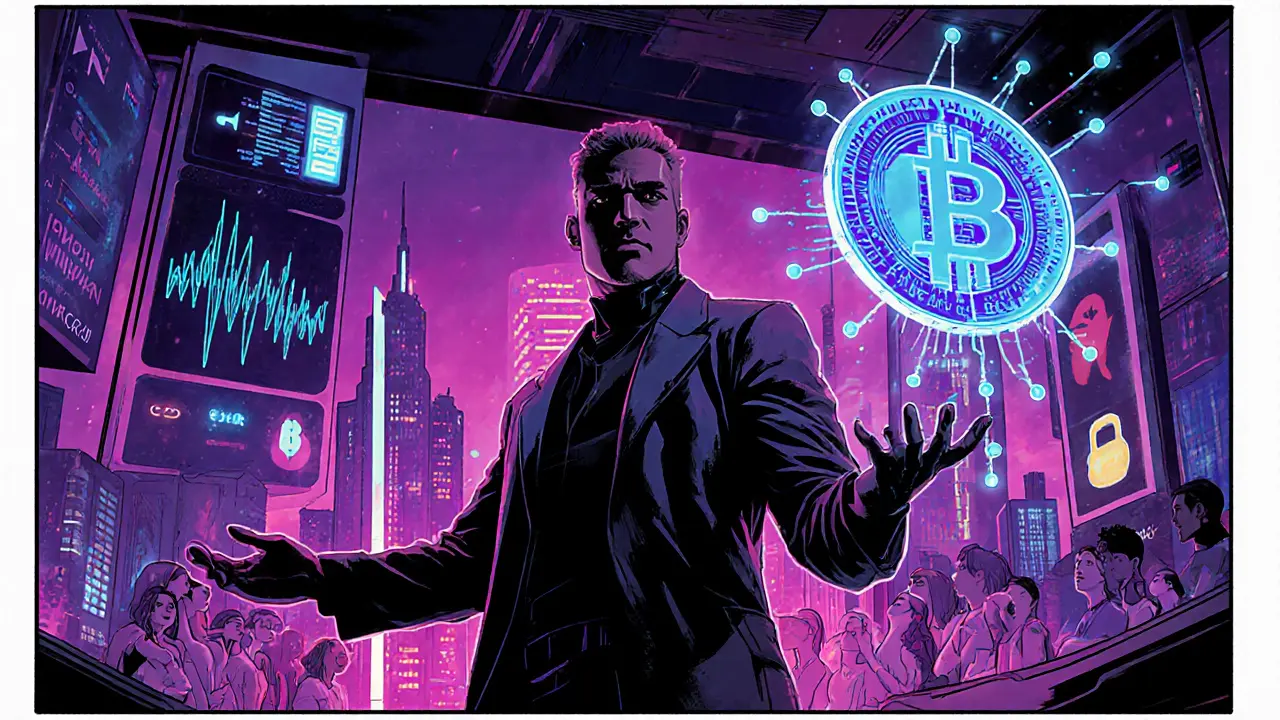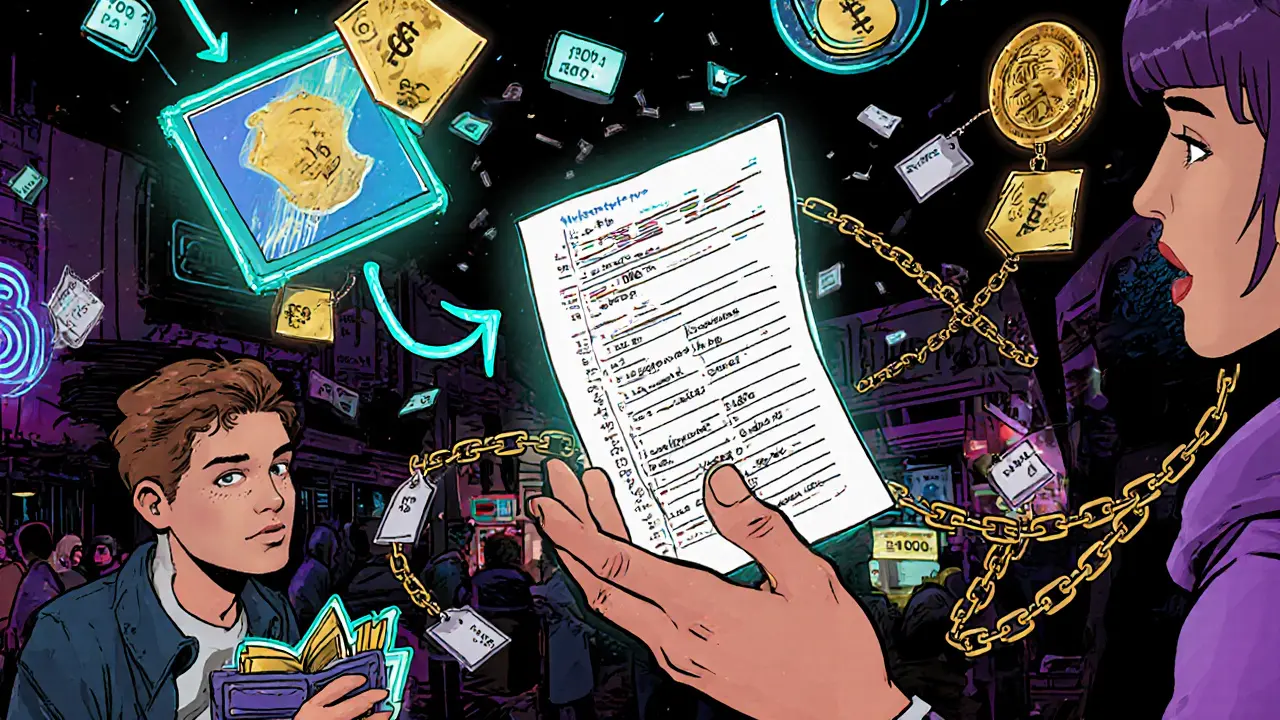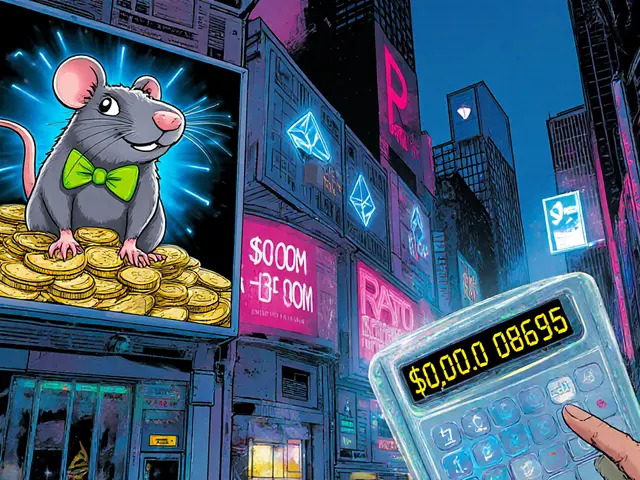- Home
- Cryptocurrency
- What Are Music NFTs? A Simple Guide to Blockchain Music Ownership

What Are Music NFTs? A Simple Guide to Blockchain Music Ownership
Music NFT Value Calculator
Initial Investment
$0.00
Estimated Value After 3 Years
$0.00
Royalty Income
$0.00
Resale Gains
$0.00
Net Profit/Loss
$0.00
This calculator provides estimates only. Actual values depend on market conditions, artist performance, and other unpredictable factors. This is not financial advice.
When we talk about Music NFTs is a blockchain‑based token that represents ownership of a unique piece of digital music, such as a song, album, video or interactive experience, we’re describing a brand‑new way to buy, sell, and collect music.
TL;DR
- Music NFTs let you own a verifiable digital copy of a song or album on the blockchain.
- Artists can earn royalties directly from secondary sales.
- Buyers need a crypto wallet and some basic Web3 knowledge.
- Value comes from scarcity, fan connection, and potential appreciation.
- The market is still young and volatile, so treat purchases as both fandom and speculation.
What Exactly Is a Music NFT?
A Music NFT is a non‑fungible token that links a cryptographic record on a blockchain to a specific piece of music.
Unlike a typical MP3 you download, the token is unique - it has its own token ID, contract address, and immutable metadata. The metadata points to the audio file (often stored on IPFS or another decentralized storage) and may include album art, lyrics, or even a link to a private video.
How the Technology Works
The backbone of any Music NFT is a blockchain that records transactions in a public ledger.
When an artist mints a token, a smart contract creates a new entry with a unique token ID. That contract governs ownership transfers and can embed royalty rules, so every resale automatically sends a percentage back to the creator.
Most platforms store the actual audio off‑chain to keep file sizes manageable, but the hash of the file is stored on‑chain, guaranteeing the file can’t be altered without breaking the token’s integrity.
Why Artists Are Jumping In
Traditional streaming pays fractions of a cent per play, meaning an artist needs millions of streams to see meaningful revenue. Music NFTs flip that model in several ways:
- Direct sales: Fans purchase the token outright, giving the artist a full‑price payout.
- Royalty splits on resale: Every time the NFT changes hands, the smart contract can forward a set percentage (often 5‑10%) back to the artist.
- Bundled experiences: Artists can attach concert tickets, exclusive merch, or behind‑the‑scenes videos to the same token.
- Funding early projects: Emerging musicians can raise capital by selling limited‑edition NFTs before an album drops.
Platforms like Opulous have built revenue‑sharing models where token owners earn a slice of future streaming royalties, creating a true fan‑investor relationship.

What Fans Get Out of a Music NFT
For collectors, owning a Music NFT feels similar to owning a rare vinyl record:
- Proof of ownership: The blockchain shows you’re the sole holder of that specific token.
- Access to exclusive content: Many artists lock special videos, backstage clips, or early‑release tracks behind the token.
- Potential appreciation: If the artist’s profile soars, the NFT’s market price can rise dramatically.
- Royalty income: Some tokens distribute a portion of streaming revenue back to owners, turning fandom into a passive income stream.
Buying, Selling, and Storing Music NFTs
The purchase flow looks a lot like buying any other crypto asset:
- Set up a cryptocurrency wallet (MetaMask, Trust Wallet, or a hardware wallet).
- Buy the required blockchain’s native token (usually ETH on Ethereum, or MATIC on Polygon).
- Connect the wallet to an NFT marketplace that supports music (Zora, Catalog, Mintable, or specialized sites like Audius).
- Confirm the transaction - you’ll pay a gas fee plus the token price.
- The NFT appears in your wallet’s “collectibles” view, and you can stream the linked track through the platform or a compatible player.
Reselling works the same way: list the token on the marketplace, set a price, and when a buyer clicks “Buy”, the smart contract handles the transfer and any royalty payout.
Risks, Criticisms, and Practical Considerations
Even though the concept is exciting, there are real challenges:
- Environmental impact: Proof‑of‑work blockchains consume a lot of energy. Many artists now prefer layer‑2 solutions or proof‑of‑stake networks to mitigate this.
- Market volatility: Prices can swing wildly. Treat NFTs as speculative assets, not guaranteed investments.
- Technical barriers: Setting up a wallet and managing private keys can be daunting for non‑tech‑savvy fans.
- Legal gray area: Ownership of the token does not always equal ownership of the underlying copyright. Always read the fine print.
- Scams: Fake drops and phishing sites are common. Verify the artist’s official channels before purchasing.
Comparison: Traditional Streaming vs. Music NFTs
| Aspect | Streaming (e.g., Spotify) | Music NFT |
|---|---|---|
| Revenue model for artists | Per‑play micro‑royalties (≈ $0.003 per stream) | Direct sale + resale royalties (5‑10% each transfer) |
| Consumer rights | Access only while subscribed; no ownership | Proof‑of‑ownership; can keep forever |
| Exclusivity | Open catalogue, no scarcity | Limited editions, unique content |
| Fan engagement | Standard playlists, limited interaction | Direct perks, tickets, community governance |
| Entry barrier | Low - just a subscription | Higher - crypto wallet + gas fees |
The Future Landscape
Industry analysts see three trends shaping Music NFTs over the next few years:
- Improved UX: Platforms are adding fiat on‑ramps, social login, and integrated streaming players to lower the technical hurdle.
- Hybrid models: Record labels are experimenting with NFTs that sit alongside traditional releases, giving fans both a streaming link and an ownership token.
- Regulatory clarity: Governments are drafting guidelines for digital assets. Clear rules could boost mainstream confidence.
For independent musicians, Music NFTs already provide a viable alternative revenue stream. For major acts, they’re a way to deepen fan loyalty and generate buzz around album drops. The technology is still maturing, but the core idea - treating music as a unique, ownable digital asset - is here to stay.

Frequently Asked Questions
Do I actually own the music when I buy a Music NFT?
You own a token that proves you hold a unique copy of the track. The underlying copyright usually stays with the artist unless the terms explicitly say otherwise.
Can I listen to a Music NFT without owning it?
Most platforms allow anyone to stream the audio linked to a token, much like a public YouTube video. Ownership grants extra perks, not a listening lock.
What wallet should I use for buying Music NFTs?
MetaMask is the most widely supported browser wallet. For mobile‑first users, Trust Wallet or the Coinbase Wallet work well. If you want maximum security, a hardware wallet like Ledger can store NFTs safely.
How are royalties paid on secondary sales?
The smart contract specifies a royalty percentage. Each time the NFT is sold, the blockchain automatically routes that slice of the sale price to the artist’s wallet.
Are Music NFTs taxed?
Tax treatment varies by jurisdiction. In many countries, buying an NFT is a capital‑gain event when you later sell it. Income from royalties is usually treated as ordinary income. Consult a local tax professional.
Cormac Riverton
I'm a blockchain analyst and private investor specializing in cryptocurrencies and equity markets. I research tokenomics, on-chain data, and market microstructure, and advise startups on exchange listings. I also write practical explainers and strategy notes for retail traders and fund teams. My work blends quantitative analysis with clear storytelling to make complex systems understandable.
Popular Articles
13 Comments
Write a comment Cancel reply
About
DEX Maniac is your hub for blockchain knowledge, cryptocurrencies, and global markets. Explore guides on crypto coins, DeFi, and decentralized exchanges with clear, actionable insights. Compare crypto exchanges, track airdrop opportunities, and follow timely market analysis across crypto and stocks. Stay informed with curated news, tools, and insights for smarter decisions.





Music NFTs sound like a cool way to own a track, but have you ever wondered who actually controls the smart contract? If the platform’s code is proprietary, a single entity could rewrite royalty splits whenever they feel like it.
Even the metadata hashes can be swapped if the hosting service is compromised, turning your “unique” copy into a copy‑paste nightmare.
That said, the technology does give artists a direct line to fans, cutting out the middle‑man streaming services that skim pennies.
Just make sure you keep your wallet keys offline; a compromised key means someone else can melt your token into crypto dust.
In short, enjoy the novelty, but keep one eye on the supply chain behind the scenes.
Supporting NFTs while ignoring their carbon footprint is a moral blind spot.
Sure, because paying gas fees for a digital sticker is exactly what I needed.
Look, most fans buy these tokens hoping for a quick flip, but the real value lies in the community perks the artist bundles – exclusive livestreams, backstage passes, even voting rights on setlists.
If you treat an NFT like a speculative stock, you’ll miss the relational capital it can build.
Don’t be surprised when the resale market dries up; the hype is manufactured by platforms that thrive on transaction volume.
Remember, the underlying song remains the same whether or not you own a token, so focus on supporting the creator beyond the blockchain gimmick.
Dear fellow music enthusiasts,
I appreciate the enthusiasm with which this guide elucidates the burgeoning realm of music NFTs.
It is heartening to observe artists exploring innovative avenues for sustainable revenue, particularly in an industry where traditional streaming royalties often fall short of supporting creative livelihoods.
Moreover, the inclusion of community‑centric benefits, such as exclusive content and direct fan engagement, underscores the potential for a more intimate artist‑listener relationship.
While acknowledging the technical barriers inherent to blockchain adoption, I remain hopeful that forthcoming user‑friendly platforms will democratize access, fostering inclusivity across diverse demographics.
In the meantime, I encourage newcomers to approach these tokens with both curiosity and due diligence, ensuring informed participation that honors both artistic integrity and environmental considerations.
Oh my gosh!!! Can you believe we are actually discussing MUSIC NFTs as if they were the future of human civilization???; It's like the artists finally discovered a way to monetize their souls while we, the bewildered masses, scramble to keep up with gas fees!!!; The very notion that a token can represent a song, a memory, a feeling-it's poetic, it's tragic, it's absurd all at once!!!; Yet, let us not forget the underlying economics: creators get a slice of every resale, fans get bragging rights, and the blockchain feasts on our transaction costs!!!; In the grand tapestry of digital art, music NFTs are but a glittering thread-bright, fragile, and oh‑so‑tempting!!!
When you first encounter the concept of a music NFT, your brain may feel as if it has been catapulted into a kaleidoscopic vortex of techno‑optimism, sprinkled with a dash of dystopian paranoia that would make an 80s cyber‑punk novelist blush.
On one hand, the allure of owning a verifiable, blockchain‑anchored shard of a beloved track is akin to acquiring a golden ticket to an exclusive sonic realm where the artist whispers directly into your digital ear.
On the other hand, the very architecture that promises immutable provenance also harbors the capacity for centralized machinations, where a consortium of developers could, in theory, rewrite royalty percentages with the flick of a code snippet.
Imagine the scene: a glittering NFT marketplace, awash in neon gradients, where users barter tokens while the invisible hand of gas fees siphons away a modest portion of every transaction, leaving the average collector clutching the remnants of their investment like a miser clutching rusted coins.
The environmental calculus cannot be ignored; proof‑of‑work blockchains have been likened to a digital dragon spewing carbon, prompting a migration toward greener, proof‑of‑stake havens that promise a more sustainable future.
Nevertheless, the community aspect is as intoxicating as a secret society’s initiation rites-exclusive behind‑the‑scenes footage, private Discord channels, and even voting rights on setlist choices, all bundled with the token like a decadent truffle.
One must also grapple with the legal quagmire that surrounds the intangible nature of these assets, for the token does not necessarily bestow the underlying copyright, leaving owners with a beautifully crafted digital certificate that may or may not grant them the right to press play on a commercial scale.
In practice, this means that while you can flaunt your ownership on a virtual wall of fame, you might still be barred from using the track in a YouTube video without explicit permission from the rights holder.
The marketplace dynamics resemble a high‑stakes poker game where seasoned collectors bluff with scarce editions, hoping to cash in when the artist's star ascends to celestial heights.
Conversely, the uninitiated may find themselves holding a token that, despite its rarity, languishes in perpetual obscurity, its market value hovering around the price of a modest cup of coffee.
There is a poignant irony in the fact that the very technology designed to democratize access can, paradoxically, erect new barriers of financial and technical literacy, effectively gating the experience behind a veil of cryptocurrency wallets, private keys, and mnemonic phrases.
Yet, for those who navigate these labyrinthine corridors with aplomb, the reward can be a sense of participation in a cultural renaissance, where fans are not merely passive consumers but active stakeholders in the artist’s journey.
Consider the psychological gratification derived from knowing that each resale ping sends a royalty check back to the creator, a feedback loop that reinforces the symbiotic relationship between musician and admirer.
Such mechanisms stand in stark contrast to the dribbling per‑play pennies of traditional streaming platforms, which often leave artists bereft after the billions of streams tally.
From a macroeconomic perspective, the infusion of capital directly into creators could spur a diversification of musical experimentation, free from the shackles of label expectations and algorithmic playlists.
However, market speculation can also create bubbles, as history has shown with other digital collectibles, where hype eclipses intrinsic value, leading to precipitous crashes that leave early adopters clutching digital ash.
In this volatile theatre, patience and a genuine love for the music become the true compass, guiding investors away from the siren call of quick profits toward a more sustainable, community‑centric model.
Thus, the prudent approach is to treat music NFTs as a hybrid of art, technology, and speculative asset-a triad that demands both critical scrutiny and an open heart.
Ultimately, whether these tokens will become the cornerstone of a new music economy or fade into a footnote of digital history remains an open question, but the conversation itself is reshaping how we perceive ownership, creativity, and value in the twenty‑first century.
The ontology of a music NFT invites us to contemplate the very nature of ownership in a digitized epoch, wherein the token serves as an epistemic bridge between creator intent and consumer perception; it is, in essence, a modern talisman, a quasi‑sacred artifact that beckons the beholder to transcend mere auditory consumption and engage with the metaphysical substrate of value 😊.
Contemplating the intersection of art and immutable ledger yields intriguing philosophical implications.
Hey folks, if you’re curious about music NFTs, think of them as a new way to collect rare tracks and maybe snag some backstage perks – it’s like having a VIP pass that you can actually own and trade later!
Honestly, the whole NFT hype feels like a circus, and if you’re not watching the strings being pulled by shadowy crypto influencers, you’re missing the drama that fuels the market's wild swings.
Remember, the best way to dive into music NFTs is to start small, understand the platform’s royalty mechanics, and share your experiences with the community – we grow stronger together 😊.
For anyone looking to get started, check reputable marketplaces that verify artist identities and provide clear guidance on gas fees and wallet security.